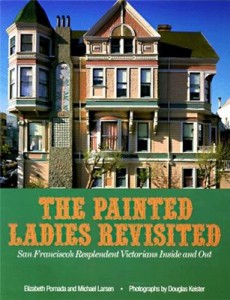by The History Chicks | Aug 3, 2011 | News

Greetings from Missouri!
I didn’t get too far from my house in Missouri before I stumbled across our first postcard subject. Beautiful, multi-hued Victorian homes are just waiting to be admired all over the country, and I got to do just that in Plattsburg, a small town halfway between Kansas City and St. Joseph.

These homes were built in the mid 1800’s to early 1900’s but didn’t officially get their name, Painted Ladies, until the 1970’s in the book Painted Ladies: San Francisco’s Resplendant Victorians by Elizabeth Pomada and Michael Larsen,with photographs by Morely Baer.

Book from the '70's which looks kinda vintage from this 2011 angle
The authors have since written a more current version, photographs by Douglas Keister:

Second verse, similar to the first
The term ” Victorian”, when you talk architecture, really is a catch- all for homes made in many different styles, and materials. Grand estate homes, to small cottages, to row style homes made of stone, brick, wood in Classic to Gothic architectural styles. All different, all Victorian. The color schemes changed as times changed. Typically there are several colors on Painted Ladies, all working together to show off the trim and architectural uniqueness of the home.
In this very short podcast, I’ll tell you a bit about the history of these homes, of the town of Plattsburg, and of other pockets of these stunning houses all over the country.
Here is the link to check out the Victorian homes of Lizzie Borden’s town: http://fallriverpaintedladies.com/
And here is the link to the Morris Arboretum, they have a miniature train display dotted with Painted Ladies. http://www.business-services.upenn.edu/arboretum/gardens_railway.shtml
I really do believe that there is beauty where ever you go, all you have to do is open your eyes. Ok, sometimes you also have to turn your head to the side and squint. But I didn’t have to do that the day that I drove into Plattsburg. I went dreading sitting in the blazing hot sun at, yet another, baseball game. I left having been treated to a gift. Beautiful old homes, preserved and displayed for anyone who had the pleasure of driving by.
Susan

by The History Chicks | Apr 27, 2011 | Biography Episode, News, Shownotes

Have you listened to the podcast on Helen Keller? We strongly recommend that you do before diving into the life of the woman we discuss in this minicast, it will make the experience just a little richer. Go ahead, we’ll wait.
While doing research for the Helen Keller podcast, we both gained an admiration for Anne Sullivan Macy and thought she deserved a little spotlight time all her own. Of course, much of her story is intertwined with that of Helen, but she was a strong, smart, brave woman who lived a life previously uncharted. She busted through barrier after barrier to create a life story worth repeating.
Born in 1866 in Feeding Hills, MA, as life dealing goes—Anne was not given a winning hand: her parents were extremely poor Irish immigrants who chose to leave the support systems in bigger cities like Boston and settle in rural New England. Her father was an alcoholic who could not hold a job, and her mother would eventually die of tuberculosis when Anne was only nine years old. Her parents had five children, although only two of them would live to adulthood.
When Anne was seven she contracted trachoma which went untreated. Had she been emigrating to the US, she would have been turned back to Ireland for this bacterial infection of her eyes—instead she lost her most of her vision.

Once her mother died, her younger sister Mary was sent to live with relatives. We read, and must believe, that Anne never saw her again. Her father was unable to care for Anne and her brother, Jimmy, so they were sent to the Tewkesbury Almshouse within a year of her mother’s death. Just hearing the grim realities of this institution would make most of us weak in the knees, but she really had a “it is what it is” attitude about it.
Sadly, her brother, who had a tubercular hip, died within a few months of entering the Almshouse. Anne was alone.
(Click here for more fabulous shownotes!)









